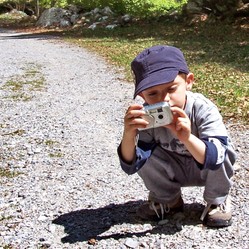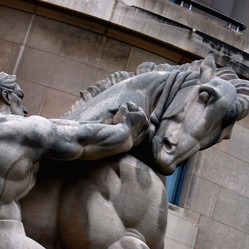One of the difficulties of photographing living creatures, from human beings to insects, is to get the subject to pose for the camera in a natural manner. With human beings (and some animals) there is often the added difficulty of getting them into position and photographing them unawares. The photographer needs to know something about stage management, misdirection and psychology.
Photographing Animals
There are many standard tricks for shooting animals, birds and fish. Seagulls in flight, for example, can be enticed into position if a companion stands close to the photographer and throws some morsels of food at the right distance. Fish in an aquarium may be kept in the plane of focus with a sheet of plain glass slipped into the water behind them.
Bait is a great help when photographing birds, animals and insects at liberty. A few crumbs will soon entice all sorts of birds to the desired spot; a single flower that has no other of the same species nearby will attract butterflies, rotting meat similarly attracts flies and other insects. Birds of prey can be attracted by imitating an owl-call, and monkeys can be kept interested with a child's toy.
With dogs and cats there is usually some suitable line of approach suggested by the animal's habits or training. It is often easy to make a placid sleepy dog look bright and alert by rattling his lead or getting dressed as though off for a walk. A cat will generally respond to the clinking of a milk jug. All such stratagems should be introduced immediately before making the exposure; the precious gleam of intelligence soon dulls if the promise remains unfulfilled.
Photographing Children
Small children that are too young to be self-conscious also react immediately to a new toy. They are so fascinated by it that they forget all about the photographer standing nearby- though he must still make himself as unobtrusive as possible. When making pictures of children indoors it is important never to shine the lamps directly on them at the start. It is best to turn the reflectors away at first, then switch on and swing them carefully round towards the field of view. In this way the children will not be scared by the sudden glare.
Candid Shots
In candid photography there are several tricks that the photographer can employ to avoid drawing attention to himself or his camera. In cold weather the camera may be slung round the neck and concealed under an ample overcoat, worn unbuttoned. When the right moment comes the camera is ready to go into action. In warm weather it is better for the photographer to stroll around casually with his hands behind his back. No one will notice the camera he is holding. For this, however, he must learn to set the camera by feel alone. All adjustments must be made before the camera comes into action.
A right-angle viewfinder deceives the victim by leading him to believe that the photographer is aiming the camera at someone else.
The "swing-round" technique is an excellent method of securing candid shots where the camera cannot be used unobtrusively. Here the idea is to focus on an object at about the same distance from the camera as the intended victim but in a different direction- usually rather more than a right angle. The real subject is observed out of the corner of the eye and, at the last instant, the camera is swung round on to the target and the exposure made right away. Any start of surprise on the part of the subject usually occurs after the shutter has closed.
You might also like
Tips for Photographing SculpturesPhotographing sculptures calls for as great, if not greater, skill in the use...
Photographing Dogs and PuppiesPhotographing dogs is difficult. The best tip to anyone attempting to take pi...













 Photographic Styleon 10/14/2011
Photographic Styleon 10/14/2011
 Interchangeable Lenseson 09/28/2011
Interchangeable Lenseson 09/28/2011
 Negative Blisters and Blemisheson 09/17/2011
Negative Blisters and Blemisheson 09/17/2011
 Photographyon 08/22/2011
Photographyon 08/22/2011


Comments
Great photography tips. Welcome to Wizzley and much success to you.